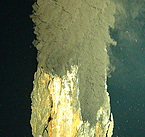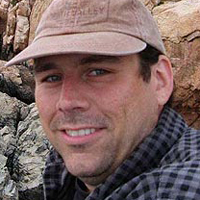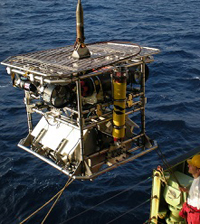World’s Deepest Hydrothermal Vents
April 15, 2010

On April 6, scientists on a Caribbean expedition discovered the world’s deepest known hydrothermal vents, also known as black smokers. The vents are located in the Cayman Trough, the world’s deepest undersea volcanic rift, running across the seafloor between the Cayman islands and Jamaica.
Watch the video: First images of the world’s deepest known black smokers
Follow the expedition through daily updates on the team’s blog.
Deep-sea vents are undersea springs where superheated water erupts from the ocean floor. Scientists are fascinated by the vents, which are often between one and two miles deep, because the scalding water that gushes from them nourishes lush colonies of deep-sea creatures. This has forced scientists to rewrite the rules of biology. Studying the life-forms that thrive in such unlikely havens is providing insights into patterns of marine life around the world, the possibility of life on other planets, and even the origins of life on Earth.

Using a deep-diving vehicle remotely controlled from the Royal Research Ship James Cook, the scientists found slender spires made of copper and iron ores on the seafloor, erupting water hot enough to melt lead, nearly half a mile deeper than anyone has seen before. The vents, which have not been officially named yet, are in water nearly 5 kilometers (3.1 miles) deep. The site was the setting for James Cameron’s film The Abyss.
The moment of vent discovery was captured in the ship’s blog:
“After five hours surveying the seafloor … HyBIS [a remotely controlled submarine] came across rust-coloured blocks of sulphide on the seafloor, which told us that the vents were nearby. After a little further exploration, a tremendous roar went up in the main lab as a beautiful cluster of black smokers came into camera view. It was an amazing feeling to know that in a world with more than six billion people, we were seeing part of our planet that no-one had ever seen before …”
The expedition is led by Doug Connelly, Jon Copley, Bramley Murton, Kate Stansfield and Paul Tyler, all from Southampton, UK.

Nick Hayman, structural geologist at the Jackson School of Geosciences, is part of the onboard science team. He is studying unusually large faults of the Cayman Trough to understand the fundamental behavior of faults worldwide.
The researchers will now compare the marine life in the abyss of the Cayman Trough with that known from other deep-sea vents, to understand the web of life throughout the deep ocean. The team will also study the chemistry of the hot water gushing from the vents, and the geology of the undersea volcanoes where these vents are found, to understand the fundamental geological and geochemical processes that shape our world.
Media interest in the discovery was intense, including coverage by Nature, Discovery, Time, CNN, National Geographic, Christian Science Monitor and BBC News.
This research spotlight contains excerpts from an April 11 press release by National Oceanography Centre, Southampton (UK) and the research team’s blog.
For more information about the Jackson School contact J.B. Bird atjbird@jsg.utexas.edu, 512-232-9623.
